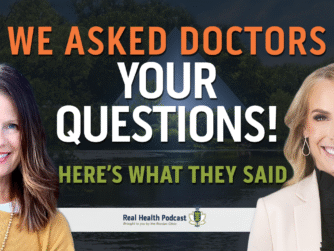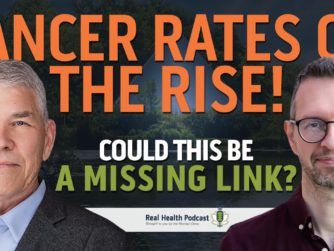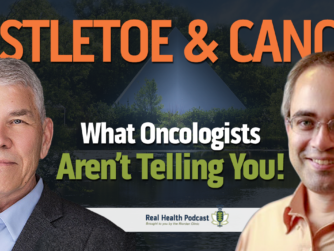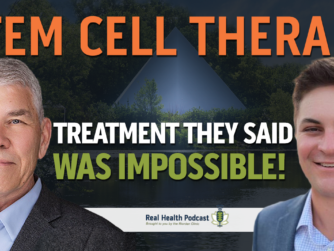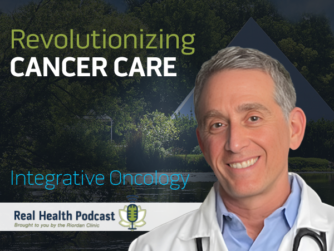In this episode of the Real Health Podcast, Chief Medical Officer Dr. Ron Hunninghake, MD, talks to Dr. Michelle Niesley, ND, MS, FABNO about some of the new research initiatives and findings here at Riordan Clinic.
Thanks to This Episode’s Sponsor
Riordan Clinic Nutrient Store: https://store.riordanclinic.org/
Links
Dr. Michelle Niesley, ND, MS, FABNO: https://riordanclinic.org/staff/michelle-niesley-nd-lac-fabno/
Dr. Ron Hunninghake, MD: https://riordanclinic.org/staff/ron-hunninghake-md/
Learn more about Riordan Clinic: https://riordanclinic.org/
Interested in becoming a Patient: https://riordanclinic.org/request-an-appointment/
Disclaimer: The information contained on the Real Health Podcast and the resources mentioned are for educational purposes only. They’re not intended as and shall not be understood or construed as medical or health advice. The information contained on this podcast is not a substitute for medical or health advice from a professional who is aware of the facts and circumstances of your individual situation. Information provided by hosts and guests on the Real Health Podcast or the use of any products or services mentioned does not create a practitioner-patient relationship between you and any persons affiliated with this podcast.
Read the Transcript
00:00:02:20 – 00:00:16:24
Narrator
This is the Real Health podcast brought to you by Riordan Clinic. Our mission is to bring you the latest information and top experts in functional and integrative medicine to help you make informed decisions on your path to real health.
00:00:17:01 – 00:00:27:09
Dr. Ron Hunninghake, MD
Well welcome everyone. This is Doctor Ron Hunninghake. We’re at the Riordan Clinic and I’m pleased to have our director of research, Doctor Michelle Niesley with us today. Hello, Michelle.
00:00:27:09 – 00:00:28:24
Michelle Niesley, ND, LAc, FABNO
Hello, doctor. Ron, how are you today?
00:00:29:05 – 00:00:42:11
Dr. Ron Hunninghake, MD
I’m great. I’m great. So what we wanted to accomplish today is to give the folks an idea of some of the new research initiatives that we’re having, and, and, you’ve been with us now. How long?
00:00:42:13 – 00:00:43:05
Michelle Niesley, ND, LAc, FABNO
Almost a year.
00:00:43:06 – 00:00:57:24
Dr. Ron Hunninghake, MD
Almost a year. So we have a grand history of, I.V. vitamin C research. And really, what we’re attempting to do is kind of even get a little bit more fundamental and bring that up to date. So tell me a little bit about that.
00:00:57:24 – 00:01:29:22
Michelle Niesley, ND, LAc, FABNO
Correct. So we just completed a study in 16 healthy individuals really looking to see what the changes are. In basic blood chemistry. Parameters are when one is receiving high dose vitamin C. So we were looking at complete blood counts, the impact on red blood cells in white blood cells. We didn’t really see any changes there. But when we looked at the chemistry panel, we did find some changes in some of the kidney enzymes for about 24 hours after high dose vitamin C administration and those normalized by the 48 hour mark.
00:01:29:24 – 00:01:53:07
Michelle Niesley, ND, LAc, FABNO
And so this is a really wonderful reference for physicians and patients to have, you know, working in oncology. Often our patients are seeing medical oncologist who are drawing labs, and those oncologists may get concerned about some of these changes in their lab values, maybe thinking it’s from the chemotherapy or immunotherapy the patient is receiving. So it’s really nice to have this reference now saying you know what?
00:01:53:07 – 00:01:57:22
Michelle Niesley, ND, LAc, FABNO
This is expected. And it does normalize within a very short amount of time.
00:01:57:24 – 00:02:17:14
Dr. Ron Hunninghake, MD
That’s great. So we know it’s safe. Of course we’ve I kind of kid when I tell people I’m not kidding, but I probably have done 200,000 I.V. Vitamin C’s here at the Riordan Clinic. And to my knowledge, we’ve not had any major issues with it, but it’s nice to get it kind of solid in a scientific method way.
00:02:17:14 – 00:02:49:14
Dr. Ron Hunninghake, MD
Yes. And because we know that around the world, more and more people are using I.V. vitamin C adjunctive. Yes. So what do you think is happening that’s allowing this to occur? Because at the beginning, you know, there was many, many naysayers ears about vitamin C that it didn’t work, that it was could cause serious complications and it might interfere with, normal, you know, care normal, infusions of chemotherapy.
00:02:49:14 – 00:02:54:13
Dr. Ron Hunninghake, MD
So is there anything to substantiate those fears?
00:02:54:15 – 00:03:27:10
Michelle Niesley, ND, LAc, FABNO
So I believe so. Part of the reason, I think that IV vitamin C has gained popularity in the in the past several decades is really obviously, Riordan was at the forefront of bringing this therapy forward initially, and the research that was initially put out by Riordan Clinic was very compelling as well. I think that many patients who have utilized I.V. vitamin C, along with their conventional care, or as an adjunct to maybe after that conventional care is done, we really see excellent side effect management.
00:03:27:12 – 00:03:49:08
Michelle Niesley, ND, LAc, FABNO
We see improvement in fatigue. I have had patients in the past where their cancer related pain has been worse when they’re not receiving their IV vitamin C. So again, symptom management. And again, there’s a lot of mechanisms in the data showing that it does boost the immune system and suppress the growth of cancer cells. Right. So it’s a really nice adjunct therapy to have.
00:03:49:10 – 00:04:15:18
Michelle Niesley, ND, LAc, FABNO
So I believe really it’s been patients who have met great success who have been able to spread the word to other patients. The research that is out there and that we’re building on, and actually even looking at in 2025, looking at ways to, some innovative ways to maybe extend the amount of time that vitamin C is available at a higher dose in the body, and see what those the safety of those methods and maybe what the impact of that might be as well.
00:04:15:20 – 00:04:48:06
Dr. Ron Hunninghake, MD
Maybe just to clarify, there are a number of infusion centers that are opening up around the country where people are getting low doses of intravenous vitamin C, 2000 4000mg and correct. And typically our our patients that come here with cancer, they’re tested at a 50 gram, dose. And even as high as a 75 gram dose. Yes. So, do you have any comments to make about the benefits of low dose I.V. vitamin C versus high dose vitamin C?
00:04:48:12 – 00:05:06:05
Michelle Niesley, ND, LAc, FABNO
Yeah, I mean, my and I defer to your experience as well. But my experience with the lower dose vitamin C, you’re getting more of the antioxidant benefit from the low dose. And a lot of times those lower dose vitamin A not a lot of the times, but sometimes the lower dose vitamin C’s are also combined with additional electrolytes like magnesium.
00:05:06:07 – 00:05:29:21
Michelle Niesley, ND, LAc, FABNO
We know how important magnesium is for the body. Magnesium deficiency results in muscle cramping, menstrual cramping, insomnia, Charley, horses, all sorts of other. You know, it’s excellent for cardiovascular health. And oftentimes B vitamins are also included in some of those lower dose infusions as well. So we’re really tackling multiple, areas of our metabolic health.
00:05:29:23 – 00:06:02:06
Michelle Niesley, ND, LAc, FABNO
So I have used those before for wound healing, for more building people up, so to speak. Whereas when you start getting into those 25 gram, 50 gram, 75 gram doses, you’re really promoting an oxidative therapy that is quite good at helping to manage infections, potentially cancer. So I think that the low doses, you know, we used to also administer them for someone who had a cold or a flu or was having trouble recovering from something, they’re really good at helping to build people up and promote detoxes, vacation.
00:06:02:08 – 00:06:32:13
Dr. Ron Hunninghake, MD
So yeah, so really what they are is kind of a nutritional boost, which who could argue that that’s that’s going to be beneficial. But for the people who have followed the Riordan approach many of you may know, and I’m just just for the for the sake of the of the general audience here, is that one of the argument against vitamin C, IV, vitamin C is that it would interfere with conventional therapy because it was an antioxidant therapy.
00:06:32:15 – 00:06:41:13
Dr. Ron Hunninghake, MD
And what people don’t know is that when you get into the 50 gram, 75 gram level, you’re creating a very respectable pro oxidant effect.
00:06:41:13 – 00:06:42:04
Michelle Niesley, ND, LAc, FABNO
Correct.
00:06:42:06 – 00:07:10:19
Dr. Ron Hunninghake, MD
Which, people say, well, how does that occur? Well, the the molecule of vitamin C looks a lot like glucose is and so it is taken up by cancer cells and it actually does end up, causing iron to be reduced, which is a it’s an antioxidant effect of the vitamin C, but that iron interacts in the cells, to create hydrogen peroxide.
00:07:10:21 – 00:07:27:12
Dr. Ron Hunninghake, MD
So hydrogen peroxide is definitely a pro oxidant. But you know the interesting thing is it’s not taken up in healthy cells in this way. So it’s selective. Yes. So it’s a selective pro oxidant instead of being a generalized antioxidant in the way we use it.
00:07:27:14 – 00:07:42:13
Michelle Niesley, ND, LAc, FABNO
That is correct. And so that’s really a great explanation of the high dose being more targeted towards some of those bad cells so to speak. And why the lower dose vitamin C acting as an antioxidant is actually quite healthy for the healthy cells.
00:07:42:15 – 00:07:54:21
Dr. Ron Hunninghake, MD
Yeah. And it reduces the, side effects of conventional therapies without necessarily interfering with their functioning. But this is not widely known by oncologists or not except it.
00:07:54:24 – 00:08:20:17
Michelle Niesley, ND, LAc, FABNO
And the half life. So vitamin C doesn’t stay in our system for very long. And so if there is concern about interference with some conventional therapies, which when you look at a lot of the data on the cell studies, most of the studies on vitamin C show either no impact on the conventional therapy or synergism. Right. So maybe sensitizing those cancer cells to the chemotherapeutic effect of that drug.
00:08:20:19 – 00:08:34:23
Michelle Niesley, ND, LAc, FABNO
And so I really believe that if there is some sort of concern, you can space out the vitamin C and maybe not get it on the same day as chemotherapy, but it’s not in our system for all that long. I mean, vitamin C is half life is quite short.
00:08:35:00 – 00:09:01:24
Dr. Ron Hunninghake, MD
Yeah, we defer to the to the, oncologist that’s in charge of their care. So we’re not pushing this, but it’s just good to know that, you know, you we’re really not interfere at all, and that we’re actually helping patients have a more comfortable experience with their chemotherapy very often. This there’s I think there’s 12 or 13 studies now on improve quality of life for patients that are getting high dose vitamin C.
00:09:01:24 – 00:09:29:15
Dr. Ron Hunninghake, MD
Correct. So, so, when you’re when you’re in a cancer situation, there’s a lot happening. And so vitamin C can actually help, help you feel better, build up your strength, help you recover from some of the negative effects of of conventional oncology. Yeah. So what do you think the future is about vitamin C? Do you think there will be, more general acceptance of it, or is it still going to be a rocky road?
00:09:29:17 – 00:09:53:10
Michelle Niesley, ND, LAc, FABNO
I think because it’s studies such as this very basic safety study that we did is really going to pave the way to acceptance by the conventional medical system. I think anything that is new and different always has a bit of a rocky road. And with integrative medicine, also, usually the way drugs are approved, medications are approved as they go through phase one, phase two, phase three clinical trials, and then they get released to the general market.
00:09:53:12 – 00:10:14:04
Michelle Niesley, ND, LAc, FABNO
Often research in the integrative medicine setting, patients are using a lot of something. And so then we’re going to research that. So sometimes it’s almost done in reverse that that herb or that nutrient is already widely available. And let’s see how far we can push the benefits of that particular substance. So I do believe that it will continue to gain acceptance.
00:10:14:04 – 00:10:36:19
Michelle Niesley, ND, LAc, FABNO
And building these bridges and working with conventional providers is really going to be important in allowing them to know that therapies like this exist, and also taking off on something that you said, you know, during active treatment with chemotherapy, radiation therapy, there may be some cautions that we need to adhere to. But when we’re looking at survivorship, right.
00:10:36:21 – 00:10:57:17
Michelle Niesley, ND, LAc, FABNO
And patients have completed their chemo and now are told by the oncologist to come back in three months, it’s kind of left up to them to figure out how to eat. And, you know, there’s wonderful nurse practitioners and other providers that head up survivorship programs. But really, this is a wonderful therapy that is still very supportive for the immune system.
00:10:57:17 – 00:11:17:03
Michelle Niesley, ND, LAc, FABNO
That just gives you no tumor killing. It happens in a different way as compared to how the chemotherapeutic work. And so it’s just giving, you know, if there were any residual tumor cells, you’re, you’re still creating this anti-cancer environment that is going to be helpful until we get those three month scans, you know, to see where things are headed.
00:11:17:03 – 00:11:30:04
Michelle Niesley, ND, LAc, FABNO
So I really believe and in the survivorship population to you’re not having to worry about that interference with chemotherapy. Right. So there’s you have a little bit more leeway to be able to dose without some of those precautions.
00:11:30:06 – 00:11:54:16
Dr. Ron Hunninghake, MD
And it’s important for people to know that at the clinic we’re not just giving vitamin C by itself. It’s part of an integrative program where we’re looking at the different. We’re actually measuring the terrains of the body. So I’m going to let you, as a natural path, kind of tell me a little bit about the terrains as you understand them, and what kind of measurements we do here that helps us understand how these terrains can impact the outcome of their cancer.
00:11:54:16 – 00:12:11:13
Michelle Niesley, ND, LAc, FABNO
Sure. So, I mean, one of the main things, if you put five people in front of us with the same diagnosis of breast cancer, not that any patient is the same, but you know, from a conventional perspective, a certain tumor size and lymph node involvement. There’s algorithms and they’re going to be treated as the same patient, so to speak.
00:12:11:13 – 00:12:39:14
Michelle Niesley, ND, LAc, FABNO
Right. Doses will be based on weight and height and everything. But they’re going to they’re going to fall into that same algorithm here at Riordan And in integrative medicine in general, what we really like to do is look under the hood and try to figure out what potentially predisposed this individual to having this situation happen. And that’s not only from a cancer perspective, that’s from a complex chronic illness perspective, a metabolic dysfunction perspective.
00:12:39:14 – 00:13:02:11
Michelle Niesley, ND, LAc, FABNO
Right. And so you can put I like to use the example of high blood pressure. It’s not cancer. But if you are, you know, so if you have three people, let’s say that can’t sleep, let’s use insomnia, okay. The first one is drinking six cups of coffee a day, right. The second one is has muscle cramps and menstrual cramps and high blood pressure.
00:13:02:13 – 00:13:29:21
Michelle Niesley, ND, LAc, FABNO
And the third one is coming home and arguing with their spouse and then can’t sleep. Right. The first one, the caffeine is having an impact. The second one probably needs some magnesium. The third one is got elevated cortisol levels at night before bed. If you give magnesium to all three people, you’re really going to will have some benefit for everybody, but you’re really going to benefit that person with the muscle cramps, the menstrual cramps, the high blood pressure, because you didn’t pick the right treatment based on that specific patient.
00:13:29:21 – 00:13:52:09
Michelle Niesley, ND, LAc, FABNO
Right. And so the thing that I love about integrative medicine is that we are doing mold testing, we’re doing heavy metal testing, we’re looking for environmental toxic burden. And we have plans and protocols that address all of those things. So we can have two patients with breast cancer, same size tumor, same stage, very similar tumor characteristics, same conventional plan.
00:13:52:11 – 00:14:08:19
Michelle Niesley, ND, LAc, FABNO
But their plan here at the clinic may be very different if one has mold exposure and the other person has heavy metals. And so really looking under that hood and addressing the personalized specific situation, health issues for each patient, I think is what makes integrative medicine so successful.
00:14:08:19 – 00:14:24:05
Dr. Ron Hunninghake, MD
It’s very personalized. And it also they’re able to tease out what’s called the biochem chemical individuality of that person. Unless you measure. And Doctor Reardon’s mantra was measure, measure, measure. He was, one of the early functional medicine doctors.
00:14:24:05 – 00:14:24:20
Michelle Niesley, ND, LAc, FABNO
Yes.
00:14:24:22 – 00:14:46:02
Dr. Ron Hunninghake, MD
By measuring, you’re able to define where the problems are, where they’re not. You know, you don’t you don’t. We necessarily we don’t necessarily do the same thing with every cancer patients because they’re going to have different measurements and different needs and different liver abilities and whatnot to how fast they process the vitamin C, how fast they deal with other nutrients as well.
00:14:46:08 – 00:14:58:14
Dr. Ron Hunninghake, MD
So this whole notion of understanding the uniqueness of each patient and then adjusting the treatment program to them, I think is always going to yield better outcomes.
00:14:58:15 – 00:15:22:03
Michelle Niesley, ND, LAc, FABNO
And I think that from a research perspective, the really exciting, you know, as we’re moving forward with Reardon into 2025, we’re really going to be measuring those outcomes. And we have always utilized our nutritional panel, our functional medicine testing to help us make decisions, you know, regarding treatment for patients. And now we’re going to be implementing more quality of life questionnaire so that when patients first come in, we can know exactly how they’re doing.
00:15:22:03 – 00:15:47:13
Michelle Niesley, ND, LAc, FABNO
And then 8 to 12 weeks in having that data and then being able to say somebody who comes to the Riordan clinic with a diagnosis of breast cancer, if they have mold present over a 12 to 16 week, you know, time period, fatigue reduced by 87%, for example. Right. And so we’ll have some of this data that we can really use to inform patients about what to expect.
00:15:47:15 – 00:16:13:06
Michelle Niesley, ND, LAc, FABNO
And I think it will also help us refine our protocols a little more, because as integrative doctors, we all have little pet tests and herbs and supplements and certain things that we, in our experience have seen work really well. So if we’re not moving the needle to the degree that we want to, I think that collecting that data really gives us the chance to evaluate and then make real time change to improve our protocols even more.
00:16:13:08 – 00:16:29:15
Dr. Ron Hunninghake, MD
And there’s another big new thing that we’re adding to the Riordan approach that you’ve helped to start. And that’s this. And you mentioned earlier the concept of survivorship. And so a survivorship program. What will that look like.
00:16:29:17 – 00:17:02:06
Michelle Niesley, ND, LAc, FABNO
Great question. So what we’re going to be doing is having patients present to the clinic. There will be some obviously lab assessment. Right. We want to individualize and figure out again you remove the things that we don’t need to pay attention to. If no heavy metals are present, we can cross that off the list. Right. But it’s going to be a 16 week program in which they’re going to be meeting with their physicians, as they normally would over that 16 week program talking about diet, the test results, individualizing their treatment plans.
00:17:02:08 – 00:17:20:16
Michelle Niesley, ND, LAc, FABNO
IVs will be involved in some of the recommendations, obviously, but then what we’re going to be doing is having touch points with the patients on a weekly basis. And I think that that’s one of the things that is lacking in medicine in general is that often patients will come and see a provider and they’ll get their instructions.
00:17:20:16 – 00:17:51:06
Michelle Niesley, ND, LAc, FABNO
If they have questions, they’ll call and ask those questions. Really? Then the provider sees them 30, 60, 90 days later. And there’s really not touch points. And so the survivorship program is going to be having weekly information on, on different topics that will be sent to the patient that will, contain some two ideas on how to clean up their pantry a little bit or how to get some chemicals out of their home, or why exercise is important and what type of exercise.
00:17:51:08 – 00:18:12:23
Michelle Niesley, ND, LAc, FABNO
But really, and then some, like a weekly online meeting where we can do some Q&A. And so really trying to enhance that patient journey and those touch points to make sure, I mean, cancer navigating through the world of cancer research or not, cancer research, navigating through the world of cancer treatment and cancer survivorship is very challenging.
00:18:13:00 – 00:18:39:22
Michelle Niesley, ND, LAc, FABNO
And so it’s nice to have a guide and someone who is there as your right hand person that you get trusted information from and that you can ask questions of. So really trying to have this guided journey as especially when patients are new to survivorship, have recently completed conventional treatment that we’re going to be piloting. And I think it’s going to be a really wonderful, wonderful way to bridge that gap between active treatment and maybe those 3 to 6 month scans.
00:18:39:24 – 00:19:14:19
Dr. Ron Hunninghake, MD
It reminds me of one of the words that I think Doctor Riordan was just a genius to come up with this. And it’s Co-learning learners. Exactly that. That this type of a program will enhance our empowerment through the process of learning, which means that we’re going to try to be working with patients on a much more personal level and helping them chart a path that makes sense to them because their chemistry is different, their life situation is different, their cancers are different, their cope, and illnesses, co-infections and whatnot.
00:19:14:19 – 00:19:29:10
Dr. Ron Hunninghake, MD
That’s all different. So the word Co is really important here in terms of us helping to really get to the core issues. Yes. Of of the cancer patients. So we’re not just doing a rubber stamp here. Everyone gets this. It’s more individualized than it has.
00:19:29:10 – 00:19:59:03
Michelle Niesley, ND, LAc, FABNO
Absolutely. Yeah. Nothing about the survivorship program is going to mandate any specific approach that you have to do a certain thing. Right. It it will all be individualized. But I think just really that communication building that community, having Riordan be the go to place where those patients can reach out and be like, hey, I need a biologic dentist, or that we can be that hub for them so that we will be producing the trusted information and education, will be helping them make some of those contacts that they want to make.
00:19:59:03 – 00:20:05:15
Michelle Niesley, ND, LAc, FABNO
I think it’s going to be just a really great service and something that is overlooked in a lot of standard medicine.
00:20:05:17 – 00:20:18:15
Dr. Ron Hunninghake, MD
Well, Doctor Michelle Niesley thank you so much for being our director of our research, but also for being a great doctor and helping us give the very best, care we can to our cancer patient.
00:20:18:15 – 00:20:25:03
Michelle Niesley, ND, LAc, FABNO
It is easy to do when I’m in a place that has such a wonderful history as Riordan does. It’s very inspiring. So thank you for the opportunity.
00:20:25:05 – 00:20:27:01
Dr. Ron Hunninghake, MD
Thank you so much.
00:20:27:03 – 00:20:47:10
Narrator
Thank you for listening to The Real Health podcast. If you enjoyed this episode, be sure to subscribe and leave us a review. You can also find all of the episodes in show notes over at Real Health podcast.org. Also, be sure to visit Riordan Clinic.org where you will find hundreds of videos and articles to help you create your own version of real health.


